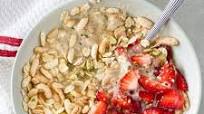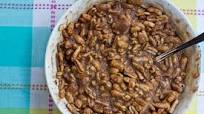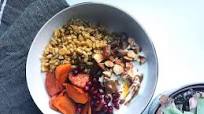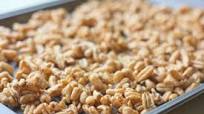What should I make for dinner tonight? This might just be the number one question that we ask ourselves almost daily over here.
Then you have come to the right place, we have rounded up 15 kamut cereal recipes that we have shared over the years.
Plus, there is such a variety of flavours in these recipes, so you are sure to find something for you. Most of these recipes are quick and easy ones made especially for busy weeknights.
15 Kamut Cereal Recipes
Kamut Breakfast Porridge
Kamut Krispies
Puffed Kamut Energy Bars
SUPERFOOD KAMUT GRANOLA
Homemade, Naturally Sweetened “Smacks” Cereal
Homemade Plant-Based Cereal
Back to School Snacks Week 3 – Kamut Marshmallow Squares
Kamut Breakfast Bowl with Seared Persimmons
Can you eat kamut as cereal?
Organic kamut. Yupik Organic Kamut Flakes are steamed, rolled, and lightly roasted whole kamut grains. Nutty in flavor, hearty kamut flakes are firm in texture; ideal as an alternative to rolled oats, and can be used in hot cereals, granolas, baked goods, and more.
Is kamut better than oatmeal?
Kamut has a lower fat content than oatmeal — only 2 grams per 100-gram serving as opposed to the 7 grams in oats. It’s also high in vitamin B6, which is important for a person’s metabolism, since it acts as a coenzyme to other enzymes in the body.
How do you eat kamut grains?
For best results, soak Kamut® berries in water overnight, then drain. Bring 2 quarts of water to a boil in a pot with salt. Add Kamut®, return to a boil, then reduce the heat to medium-high and boil uncovered until soft, about 40–60 minutes. Drain off cooking water, then serve.
How do you eat puffed kamut?
It stays firmer longer in milk than puffed rice, about on a par with puffed wheat, and has a similar taste to puffed wheat. There is no added sugar, which means it is healthy as well as delicious. I eat it with fresh fruit, such as strawberries, blue berries, raisins, peach slices, or sliced bananas.
Can you eat raw kamut flakes?
Uncooked grains
You can eat raw grains like oats, amaranth, millet, barley, buckwheat and kamut; typically by soaking and sprouting them first. That can make them easier for your body to digest and absorb their nutrients.
Do you have to soak kamut before cooking?
Unlike in the rice cooker, though, you definitely need to soak your kamut before cooking it in your pressure cooker. What is this? Soak your kamut overnight or do a quick soak, just like you’d do with dried beans.
Is Kamut good for weight loss?
Studies show that eating Kamut reduces cholesterol, blood sugar, and inflammation throughout the body. It’s also easier to digest than regular wheat. Kamut’s ability to stabilize blood sugar and reduce inflammation make it a great weight loss staple.
What is a good grain for breakfast?
Move Over Oatmeal — 7 Other Healthy Grains To Try for Breakfast
- Amaranth. This pseudocereal (not a true grain, but a seed) was a staple food of the Incas, Mayas and Aztecs. …
- Quinoa. …
- Kamut. …
- Millet. …
- Buckwheat. …
- Brown rice. …
- Now for the tasty, healthy toppings.
Which grain is best for weight loss?
Here are the best whole grains that you may want to include in your weight loss diet:
- Barley (Jau) …
- Finger Millets (Ragi) …
- Brown Rice. …
- Buckwheat (Kuttu) …
- Quinoa.
Is Kamut similar to rice?
In appearance, the kamut grains or berries looks similar to brown rice only slightly more elongated, a little plumper with a distinct “hump”. When cooked though, they are much more gorged and juicier, similar to sweet corn kernels but chewier and with a rather sweet nutty flavour.
What is Kamut good for?
Packed with nutrients like protein, fiber, zinc and magnesium, Kamut® is a tasty grain that offers a variety of potential benefits. A diet rich in fiber can aid digestion and keep things running smoothly.
Is Kamut chewy?
Kamut berries have a chewy, firm texture and a bronze-gold color. They can be used interchangeably with barley, wheat berries, or even corn. Kamut is a slower-cooking grain, and therefore holds its shape well and can be used in soups and stews without getting mushy.
What does puffed kamut taste like?
The flavor profile is similar to many other whole grains – rich and nutty and with a firm, slightly chewy texture. Kamut thrives in dry weather, which makes sense in that it hails from the desert climate of Iran.
Is puffed kamut good for you?
Kamut provides you with fiber, a type of carbohydrate, and protein, an essential macronutrient. Protein plays a central role in maintaining strong tissue and aids in oxygen transport and immune function, while fiber helps lower your cholesterol, fights type 2 diabetes and maintains digestive health.
What is the difference between wheat and kamut?
What is Kamut? Kamut Khorasan wheat is a non-hybridized ancient wheat. It contains wonderful whole grain nutrition, a firm texture, and rich, nutty, taste. In comparison to modern wheat it has more protein, amino acids, vitamins, and minerals–including selenium, zinc, and magnesium.
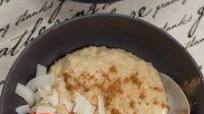

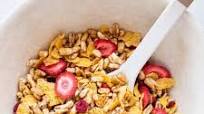
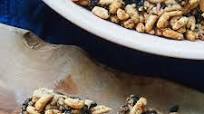


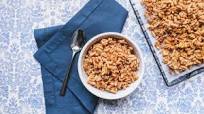
![Cocoa Puffed Rice and Kamut Crispies [Vegan] Cocoa Puffed Rice and Kamut Crispies [Vegan]](https://static.selectedrecipe.com/images/recipes/cf4f498df1da425347ef151459533902.jpeg)
